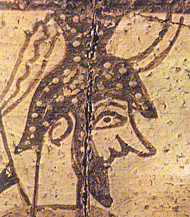 |
The Greek Age of Bronze
Late Helmets |
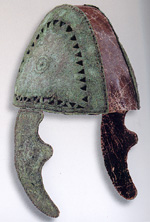 |
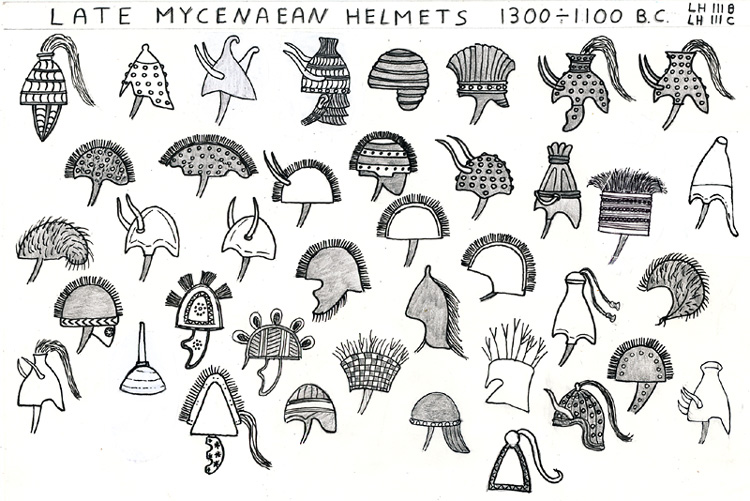 Late Achaean and Aegean helmets 1300-1100 BC Based on pottery, fresco, sculpture representations and partial findings. Late Achaean and Aegean helmets 1300-1100 BC Based on pottery, fresco, sculpture representations and partial findings. |
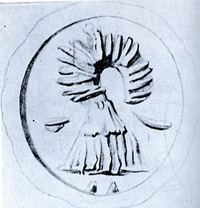 |
On a seal stone probably dated around LH IIIB/C a conical helmet without cheek guards is represented. The helmet is made of two rows of boar tusks and it has a large round crest similar to the one of some early achaean helmets (see also the page dedicated to the early helmets). |
| A very beautiful ivory representation of a late boar tusks helmet is from a grave in Spata Attica dated around LH IIIB. This helmet is composed by an embossed lower ring probably made of bronze, three rows of boar tusks, a large upper crest holder, a neck protection and long cheek guards. The neck protection and the crest holder were more likely made with the same leather coming from the helmet's internal structure. The long cheek guards were reinforced with boar tusks as well. Because their strange position respect to the guards the ears were probably ivory decorative relief parts of the cheek guards. The central hole was probably used to fix the relief on the furniture even if the possibility of horns location can't be excluded. |
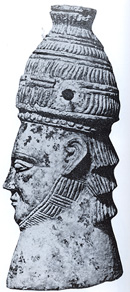 |
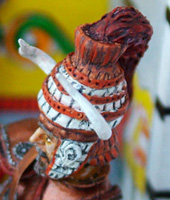 |
Based on the above ivory relief a possible reconstructon of a late achaean boar tusks helmet with embossed bronze lower ring, cheek guards reinforced with boar tusks, decorated with ivory fake ears and horns can be hypotized. |
| From the same period are some ivory sheets from Mycenae representing conical boar tusks helmets. These helmets seem equipped with neck protection but without cheek guards.
|
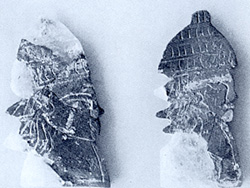 |
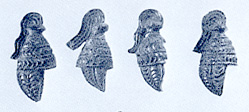 |
From Mycenae are also these small ivory representation of boar tusks helmet dated LH IIIB. The helmets are equipped with horse tail and large cheek guards reinforced with two lines of boar tusks. |
| On this pottery fragment from Tyrins dated LH IIIB a simple conical boar tusks helmet is depicted together a tower and a figure-of eight shields. This specimen is very important because give evidence that these defensive elements, even if less common, were still used in the late periods of the Late Helladic time as also attested in the Iliad (*1). For what concern these type of shields see also the page dedicated to the body shields.
|
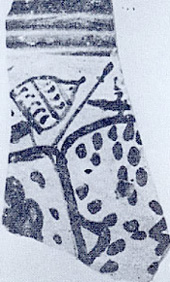 |
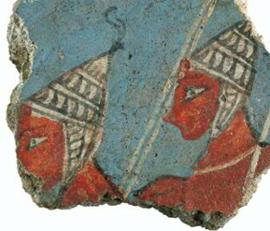 |
Two boar tusks helmet with triangular cheek guards, upper knot and plumes are well depicted in this fresco fragment from Orchomenos dated LH IIIB. |
| So far the later finds of a boar tusked helmet was found in a Knossian Subminoan burial of the North Cemetery at Knossos (Tombs 200, 201, 202 SW). This is a further evidence as this kind of helmet was still used in the final period and even right after the end of the Greek Age of Bronze. Furthermoe we can't exclude that some examples of this typical Minoan and Achaean helmets also survived during the Iron Age period being a boar tusked helmet represented on a plaque on Delos in the 8th century BC. |
| A triangular bronze cheek guard part of a bronze or composite helmet has been found in one Achaean grave in Ialysos Rhodes dated around LH IIIB. |
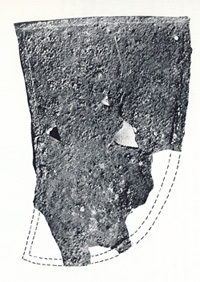 |
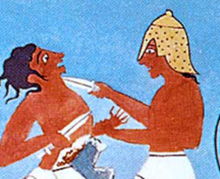 |
On a fresco from Pylos dated around LH IIIB a clear representation of a conical embossed helmet with upper knot, long nose and neck guards is depicted. Because of its colour and the general design this type of "hollow-eyed" helmet was probably made of bronze. |
| Based on the fresco representation a possible reconstruction of this late achaean bronze helmet can be made. The small dots can be both interpreted as embossed decorations or reinforcement elements, probably rivets made of bronze or other material like tin or lead. Even if not visible in the fresco representation this type of helmet was more likely equipped with an internal padding and leather chin strap.
|
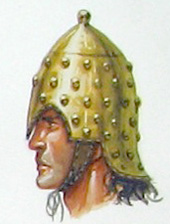 |
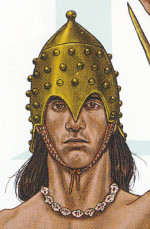 |
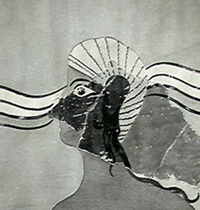 |
In another fresco from Pylos also dated LH IIIB a man is wearing a fabric cap similar to the ones represented in some Egyptian relief or fresco. These type of cap could also be intended as protective elements or hair holder to be used under some type of helmets. |
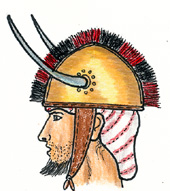 |
| Some type of simple conical helmets with concentric bands "beehive" style are still present in the late achaean period as attested in these pottery fragments from Mycenae dated around LH IIIC. |
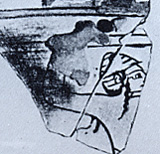 |
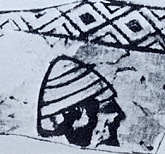 |
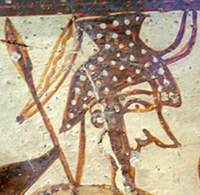 |
Some of the most famous achaean late helmets are represented in the side A of the warriors vase from Mycenae dated LH IIIC (about 1200 BC). Even if at first sight all the helmets, shown in the side A, look equal some small differences are present and at least three types of helmets can be identify. All the helmets have similarity in general shape, horns, upper crest holder, plumes, and embossed or reinforced elements in the helmets' surface. This first type seems to be without the cheek guards, being the small lateral parts ended at the temples thus the helmet was more likely equipped with a large chin strap. |
| The second variant of this helmet is basically the same of the first one except that it seems equipped with cheek guards as attested by the presence of some embossed elements. In all the helmets the horns curves up from the front of the helmet into the framing band, probably intended to spring out diagonally. |
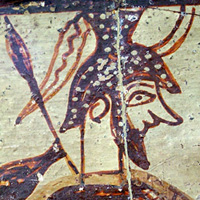 |
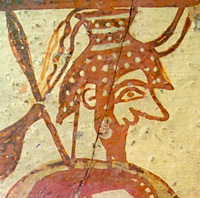 |
The third variant shows three bands located around the upper crest holder. These could be interpreted as decorative elements or reinforcement strips made of different material. Also this variant seems equipped with cheek guards. |
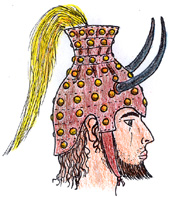 |
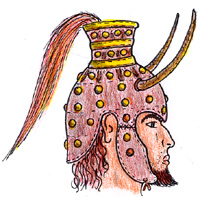 |
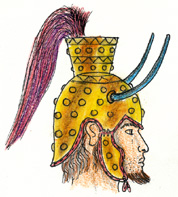 |
Even if these helmets are generally interpreted as made of leather or other perishable material reinforced with bronze discs, we can't exclude the hypothesis that similar helmets could have also made of embossed bronze. This bronze version could have been probably made in the same way as the helmet from Pass Lueg (see the section of the central/north European helmets) or some Danish embossed bronze horned helmets. |
 |
The bronze reinforced bosses for the perishable material helmet were probably similar to the ones found in the warrior grave A from Kallithea or Lakkithra dated LH IIIC. |
| Several small bronze bosses have been also found in the warrior grave from Liatovouni dated 13th-12th Century BC. Even if these buttoms have been interpreted as fixation elements of a perishable material corselet (see also the page dedicated to the corselets) their interpretation as reinforced elements of a leather helmet can't be excluded. |
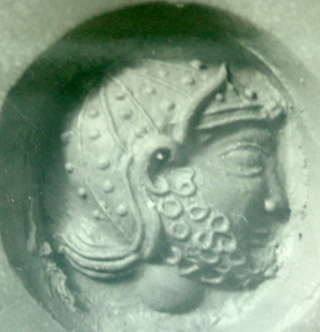 |
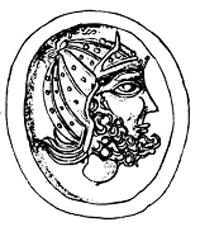 |
An embossed helmet with horns probably similar to the ones of the warriors vase (even if without crest) is also represented on this seal from Cyprus dated about 1200 BC. |
| Aother helmet which shows similarity with the ones of the warriors vase is attested in a statue from Ugarit Syria also dated around 1200 BC. This helmets shows several similarity with the ones represented in the warrior vase like the general shape, upper crest holder and horns. This statue has been found in an area where the achaean influence is well attested by pottery and other findings. |
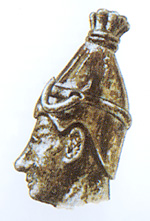 |
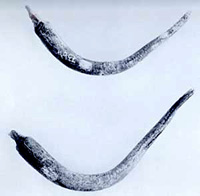 |
Very interesting are two horns made of lead found in Dendra. These elements were surely part of an helmet as well attested in several achaean helmet representations. Being made of metal these horns should have been installed on a very rigid structure more likely a bronze helmet. Horned helmets of various types increase in popularity in Greece just before the final period of the Late Helladic time. |
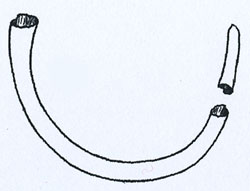 |
A beautiful gold horn probably decorative element of an helmet has been also found in the Late Helladic palace of Athens located on the Acropolis. |
| Different type of horns made of boar tusk, deer horns or wood are well attested in several achaean settlements. Of course not all of these elements are necessarily related with helmets. |
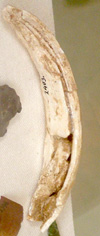 |
 |
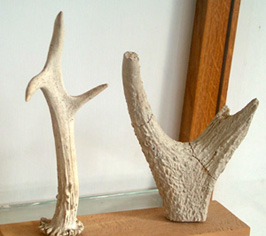 |
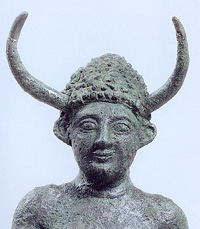 |
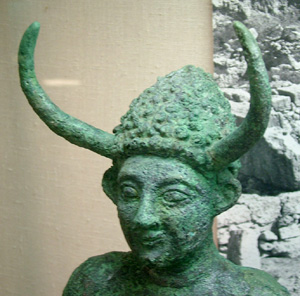 |
A Conical helmets with very long horns is represented in this statue from Enkomi Cyprus dated LH IIIC. The helmet seems made of untanned animal skin or "hedgehog" style. Indeed we can't exclude the possibility that this helmet could have been also made of embosed bronze being such long horns more stable if fixed in a metal structure. |
| A conical horned helmet without cheek guards is well attested in this statue always from Enkomi dated around 1200 BC. Also in this case the helmet lower edge is similar in shape to the one from Ugarit and the ones represented on the warrior vase. |
| 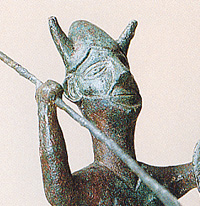 |
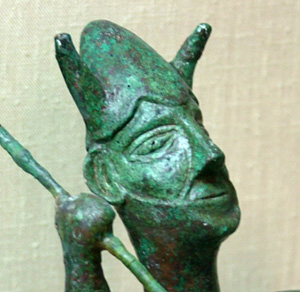 |
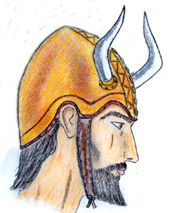 |
This helmet was more likely made of bronze and was fixed with large leather chin strap. Of course we can't exclude that similar type of helmets could have been also equipped with bronze cheek guards and central crest |
|
| Even if very schematic in details a possible helmet with horns, upper tube and crest holder is also represented in this crater fragment from Pylos dated around LH IIIC.
|
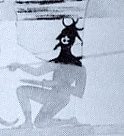 |
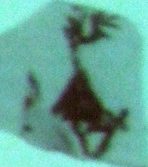 |
In this other pottery fragment from Kynos dated LH IIIC a warrior seems depicted with an helmet furnished with tube and a long crest.
|
| Several type of conical helmets with horns are worn by the Sherdan Sea People as well attested in some Egyptian representations (see also the page dedicated to the Sea People).
|
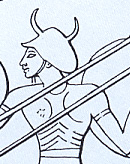 |
| A conical helmet with horns and top ball-like knob, similar to the ones worn by some of the Sherdan Sea Peoples, is represented on a seal stone dated XII Century BC from Thebes Greece. That seal very likely came from either Cyprus or northern Syria. Cylinder seals of the Late bronze Age which show gods or supernatural beings wearing horned helmets with a large ball or knob at the top have been found in Cyprus and Ugarit
|
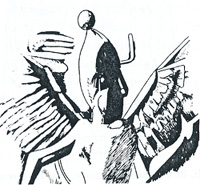 |
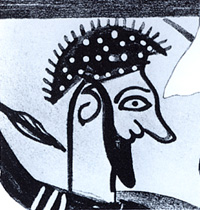 |
On the side B of the famous warriors vase from Mycenae one of the warriors is represented with a large helmet probably made of leather or un-tanned animal skin "hedgehog" style. The helmet is without cheek guards and was reinforced with metal bosses. The upper bristles sometimes interpreted as the hairs of the un-tanned animal skin were more likely the representation of a short central crest. |
|
| A possible reconstruction of this helmet made of leather, untanned animal skin or other perishable material reinforced with bronze bosses and a central short crest can be reasonably hypotized. The large pouch could have been also used to keep enclosed the warrior's long hairs.
|
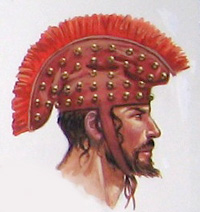 |
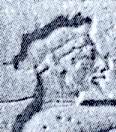 |
Similar non stiff large helmet is also attested in the Egyptian relief of Karnak temple being worn by some captives Shasu warriors. |
|
| In this painting from Tiryns dated LH IIIC the warriors and charioteers are also equipped with large round helmets with short upper crest or made of untanned animal skin "hedgehog" style. |
| 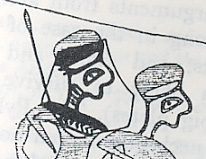 |
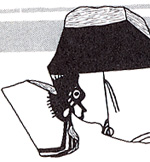 |
In this krater from Tiryns dated LH IIIC the warrior is also equipped with a large helmet with short upper crest or made of untanned animal skin "hedgehog" style. |
|
| In this naval battle scene depicted on a krater from Bademgedigi Tepe in the west Anataolia dated LH IIIC the warriors are also equipped with large helmets probably made of untanned animal skin "hedgehog" style. |
| 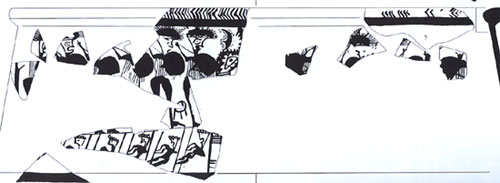 |
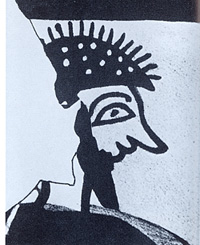 |
On the side B of the warriors vase a low profile helmet without cheek guards and a short crest is well represented. Also in this case the helmet was more likely made of leather or un-tanned animal skin "hedgehog" style reinforced with metal bosses. This is probably a stiff cap, made in two halves from front to back, with a spray crest clamped in the joint. Some scholars have also suggested that similar helmets could have been actually made of hedgehog skin. |
|
| Similar helmet without the embossed or reinforcement elements is also represented in this pottery fragment from Tiryns dated LH IIIC. Also in this case the helmet can be hypotized made of perishable material like untanned animal skin and/or equipped with a short central crest. Indeed the possibility of a simple low profile bronze helmet with short crest can't be excluded. |
| 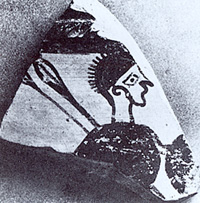 |
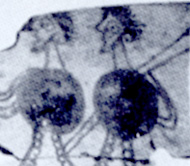 |
Others "hedgehog" style helmets are also depicted in this other pottery fragment from Tiryns dated LH IIIC. These type of helmets were largely used during the last periods of the Late Helladic time as well attested in several representation. Mostly of these helmets were more likely made of leather or untanned animal skin as also attested in the Iliad (*2) |
|
| Conical "hedgehog" style helmets with cheek guards, low crest and decorative bosses are shown on a pottery fragment dated around 1200-1100 BC found in a large Mycenaean/Proto-Geometric cemetery of Voudeni near Patras. Because of its general shape we can't exclude that this helmet could have been made of bronze with embossed decoration. Based on other helmet findings coming from this area the Professor Ioannis Moschos suggests that the internal parts of these helmet was probably made of tightly knitted straw.
|
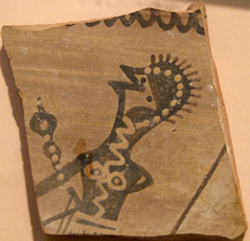 |
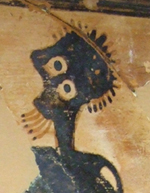 |
An "hedgehog" style helmets is aslo worn by this warrior represented on a krater dated around 1200-1100 BC found in the same large Mycenaean/Proto-Geometric cemetery of Voudeni near Patras.
|
| Two "hedgehog" style helmets with low crest and decorative bosses are visible on another pottery fragment dated around 1200-1100 BC also found in Voudeni. In this case two rowing warriors are represented.
|
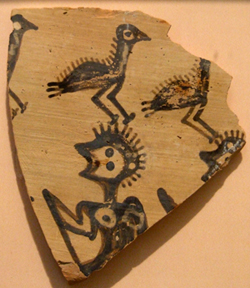 |
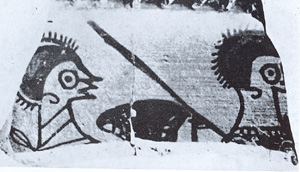 |
On a pottery fragment from Iolkos dated LH IIIC a similar type of low profile "hedgehog" style helmets are represented. These helmets completelly cover the warriors head like a bonnet. Also in this case the helmets were probably made of perishable material, the central short crest or untanned animal skin hairs are also represented.
|
| On a pottery fragment from Lefkandi dated LH IIIC a possible warrior with a simple cap-like helmet is represented. This figure may have formed part of a file of soldiers on the march. What has been described as the long-nosed warrior's curly beard may rather be the chin strap of his helmet.
|
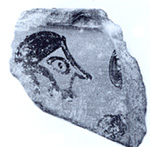 |
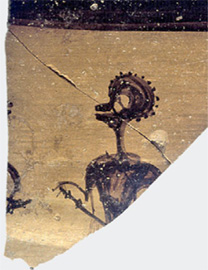 |
A warrior with a low profile helmet with small tufts and possible Naue II sword is represented on this other krater fragment from Kalapodi dated around 1130-1070 BC.
|
| In this collared jar fragment from Tiryns dated LH IIIC two warriors seem wearing full head helmets with crest in separate tufts and long horse hair. The very schematic style of the artist do not allows a detailed identification of these helmets which more likely were made of bronze. |
| 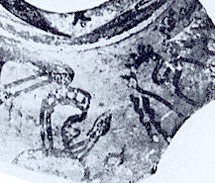 |
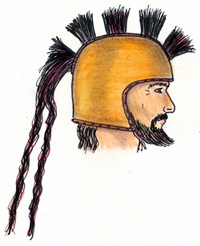 |
Despite the very schematic representation a recostructive hypotesis of such helmets can be reasonably made. This low profile full head bronze helmet could have been made in two halves internally padded and decorated with some separate crests and long horse tail. |
|
| An helmet with several crest or horns and horse tail seem also worn by the horse-mounted soldier painted in this krater fragment from Crete dated LH IIIC. Despite the general opinion this representation (as well as some others) attested as horse-mounted warriors were also present during the late achaean time.
|
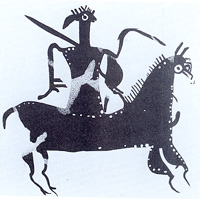 |
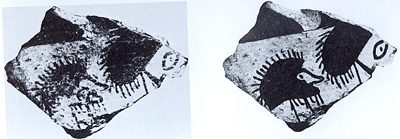 |
On this krater sherd from Mycenae dated LH IIIC two strange type of "hedgehog" style helmets are illustrated. The one on the left seems equipped with very large cheekpieces decorated with bristles; neck protection and short crest are also present. The helmet on the right looks like a baggier with a beretlike pouch in back. Because the long and bended bristles this helmet was surely made of untanned hairy animal skin. |
|
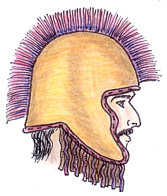 |
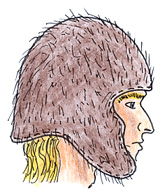 |
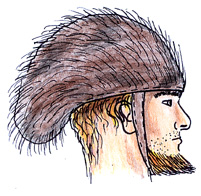 |
Even if the late achaean "hedgehog" style helmets are generaly interpreted as made of untanned animal skin, a possible bronze reconstruction of the first helmet can be reasonably hypothize. Because its general shape this helmet recalls some type of helmets used during the Greek Archaic time. The reconstruction of the second helmet is easier being this type of helmet like a baggier with a large pouch in back.
|
| The same type of "hedgehog" style helmet like baggier with a beretlike pouch in back are worn by some captives Shasu warriors represented in the Egyptian relief of Karnak temple. Also in this case the large pouch could have been also used to keep enclosed the warrior's long hairs. |
| 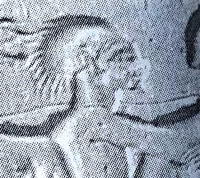 |
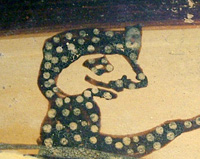 |
On a krater fragment from Tiryns dated LH IIIC a very schematic representation shows a charioteer probably wearing a non metallic full head helmet reinforced with bosses.
|
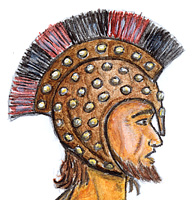 |
The very schematic style of the artist do not allows a detailed identification of this helmet thus only a very hypothetical and speculative representation can be made. |
|
| A krater sherd with a helmeted head from Mycenae dated LH IIIC is all in fine outline drawing. The helmet has a rounded crown with a fringe of bristles; more likely it is made of metal, since the forms are more conical and rigid than the usual "hedgehog" style helmet. In the front there seems to be a horn on the brow as on the warrior vase. As shows in the page dedicated to the armour this warrior is probably equipped with a segmental armour with a "Dendra" style neck protection. |
| 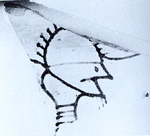 |
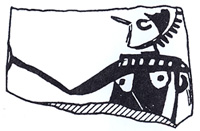 |
Similar helmet also in this case probably made of bronze is depicted in this pottery fragment from Iolkos dated LH IIIC . |
|
| On the colorful stele from Mycenae very few details of one helmet can be barelly identified. It seems a "hedgehog" style helmet with short crest (probably with separate tufts), neck protection and cheek guards. |
| 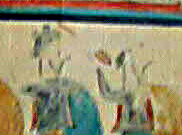 |
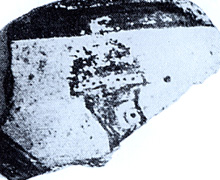 |
Another very interesting helmet is attested in this pottery fragment from unknown provenance probably dated LH IIIB/C. This rigid helmet seems made by two part; the lower element adherent to the warrior's head is probably composed by a neck protection a circumferential rim and the chin strap.
The upper part larger than the head rim is composed by five bands in dark and white probably to be intended made of different material or painted in different colour, the white bands seem to have reinforced discs. A short central crest is also represented. |
|
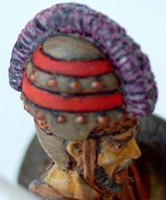 |
Based on these elements a possible reconstruction of this helmet can be reasonably hypothized. The reconstruction shows a leather or other perishable material cap composed by longitudinal bands painted in different color, two of these sections are decorated with bronze bosses. A central short crest is clamped in the middle of the cap. The neck protection and chin starp are parts of the internal helmet structure, an embossed bronze ring is the lower helmet reinforcement around the warrior's head.
|
| A conical helmet probably made of bronze with decorations or in perishable material reinforced with metal elements, is well represented in this ivory mirror handle from Enkomi dated 12th Century BC.
|
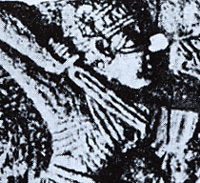 |
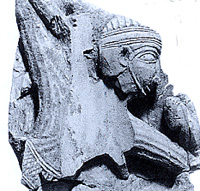 |
In this other very fine ivory carving from Enkomi dated 12th Century BC, a warrior fighting a griffin wears a low profile helmet with neck protection and throath strap. Also in this case the helmet was probably made of perishable material reinforced with bronze plates.
|
| A solidly painted low profile helmet with a hatched band along its bordes is depicted in this krater fragment from Lefkandi dated LH IIIC. The dark "hedgehog" helmets with a bristled crest seen on contemporary vase representations from other Achaeans sites may have a reserved lower border, either patterned or left plain.
|
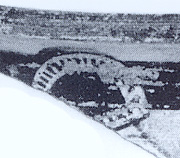 |
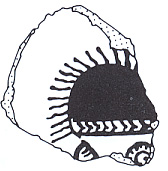 |
On this pottery fragment from Mycenae dated LH IIIC an "hedgehog" style helmet seems represented. The helmet was probably reinforced in the lower part by a metal decorated ring. The two strange lumps were probably decorative bosses located in the helmet's neck protection. |
|
| Another strange helmet is depicted in this fragment from Tiryns dated LH IIIC. This helmet seems composed by a low profile cap, a very long neck protection and a reinforcement ring around the lower edge. No cheek guards seem to be present in this type of helmet. |
| 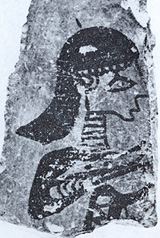 |
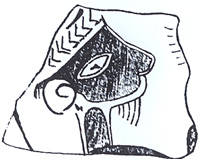 |
Metal reinforcement ring as part of the helmet's lower edge are clearly represented in this pottery fragment from Mycenae dated LH IIIC. In this case no clear identification of the helmet is possible being no other elements visible. Bronze rings intended as part of the helmets' lower edge are also mentioned by Homer (*3) |
|
| The metal rings are also a typical part of the as called "Feather Headgear" attested during the last period of the Bronze Age in several images coming from different Aegean areas as well as south, east and central mediterranean places. The general structure of this helmet was probably made in much the same way as the internal structure of a boar tusks helmet but with the leather thongs turned up at the ends and held in place with one or more metal rings. This helmet was sometime equipped with neck protection and was secured with a leather chin strap. A typical "Feather Headgear" is represented on this ivory casket from the Achaean settlement at Enkomi Cyprus dated around twelfth Century BC. |
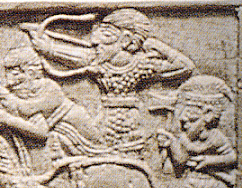 |
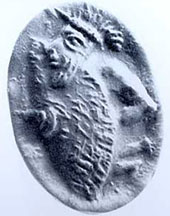 |
A typical "Feather Headgear" is also worn by the warrior represented in this seal always from Enkomi Cyprus dated around 1190-1180 BC.
|
Very interesting man's head carved from a stag's horn from Crete. This bearded man seems to wear a "feathered headdress" and his general aspect shows a striking resemblance to the above mentioned Enkomi warrior.
The precise date of this specimen is not clear for some scholars it could be 12-13th century for some others it is probably much more older around 1700-1600 BC thus of the same period of the Phaistos disk.
|
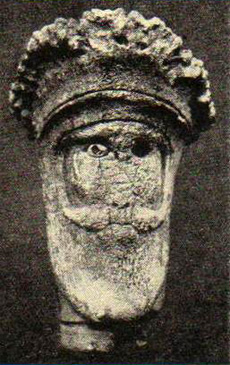 |
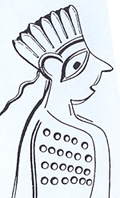 |
A probable "Feather Headgear" is also depicted on a Mycenaean style pottery from Ugarit Syria date around 1200 BC. Of course not all the Achaean style vase were made in Greece and it isn't certain whether the painting represent an Achaean scene or a scene tailored to the tastes of the Cyprus or Ugarit market. |
|
| The most remarkable and famous images of "Feather Headgear" are from some Egyptian relief like the one from Medinet Habu. These helmets were the typical headgear of the Philistines Sea People (see also the page dedicated to the Sea Peoples)
|
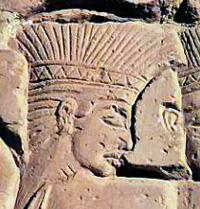 |
| Very important findings of bronze reinforcements of a "tiara like" helmet are from the warrior grave A in Kallithea dated about LH IIIC. These are the remains of strip-embossed pieces, flat strip pieces, and small bronze bosses, all these elements have long nails by which they were once fastened to the perishable material inside headgear which based on a similar helmet found in Portes it was made with tightly knitted straw.
|
| Of these strips some have been restored, the larger fragments are about 268 mm, 238 mm, and 172 mm respectively, width 22 mm and 30 mm. They have been restored in wax and are distinctly bend. Other pieces not restored belonging to outer ridges of these or other strips, preserve the long nails by which they were once fastened to the perishable material corselet. Some strips are decorated on either edge with double ridges, the space between filled with a line of beading. Another fragment is left plain except for a single ridge following either edge.
|
| Some of the Kallithea elements have very close parallels with the bronze band fragments and bosses from Lakkithra Cephalonia dated from the same period. These parts have been also identified as remains of a "tiara like" helmet or reinforcement/decoration elements of a perishable material helmet. |
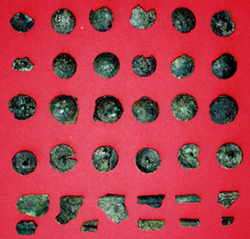 |
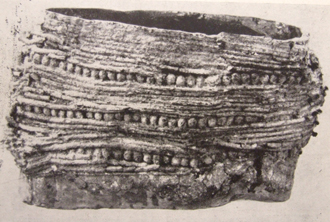 |
A beautiful example of this kind of helmet is the bucket-shape cylindrical object found in the tholos tomb at Praisos-Foutoula Crete also dated around 1200 BC.It is composed by several horizontal ribs that alternate with single horizontal rows of ornamental rivets. These strips and rivets are exactly the same as the ones from Kallithea |
| Another well preserved specimen of an Achaean "tiara like" helmet has been found in a grave in Portes-Kephalovryson dated around 1200-1100 BC. As described by Professor Ioannis Moschos on his archaeological report this helmet it is cylindrical in shape with an oval section and straight sides. Its preserved height is 15.8 cm, its width is 18.7-19.1 cm and its length is 23-23.6 cm. The surface is beautifully decorated with bronze strips consisting of horizontal ribs that alternate with single horizontal rows of ornamental rivets. The two ends of the helmet are dressed with wider bronze bands that bear relief ridges at the edges. The band of the top is decorated on the face by three nipples. |
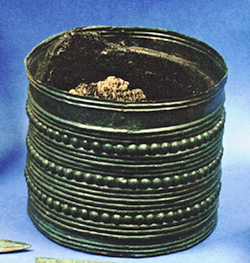 |
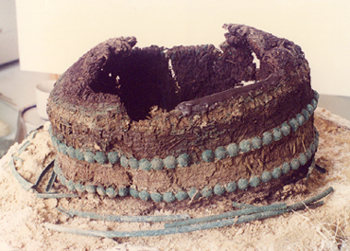 |
All these separate strips, sixteen in total, and the rivets were fixed on an inside headgear made by a plain straw hat tightly knitted. It was in the shape of the helmet that is oval cylindrical. Its closed top was not salvaged, however enough evidence was preserved in order to assume with absolute certainty that it was curved, consisting of the only visible section of the straw hat which was slightly projecting over the bronze lining. |
|
| Based on the above mentioned specimens we can thus hypothize the general outfit of these kind of "tiara like" helmet. The first one is decorated with a "feather style" crest similar to the one worn by the sea peoples, in this case made of the same straw of the inner cap. The second one is decorated with rushes following the representation in some pottery fragments of possible similar helmets from Serayia island of Kos. |
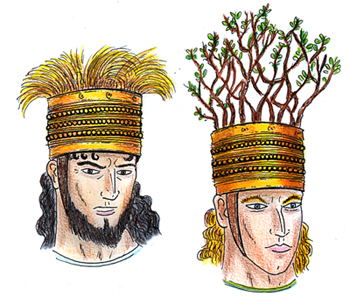 |
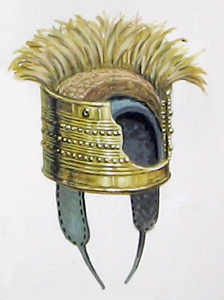 |
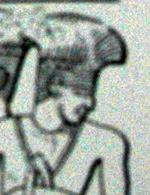 |
A "feathered" helmet with an unusual high tiara seems also worn by this Denyen warrior represented on a relief of the Medinet Habu temple (see also the page dedicated to the Sea Peoples). |
|
| A close parallel of this kind of "tiara like" helmet can be identify in a very unusual helmet depicted in this krater fragments from the Late Achaean settlement of Serayia in the island of Kos near Rhodes dated around twelfth Century BC. This helmet is shaped like a bag, it seems to enclose the face to the jawbone, slanting down to cover the back of the neck. A nose protection seems also represented and the warrior's eyes are conspicuous in the centre of this armour. The flat top of the helmet is crested with a series of tall rays pronged or branching out in Y-forks, more like plants (rushes?) than feathers, although it is difficult to imagine what else could be intended. |
| 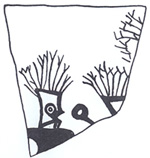 |
 |
A similar helmet shaped like a bag and decorated with rushes is also depicted in another krater fragment always from Serayia. In this images the warrior is probably riding a chariot |
|
| Despite the oddities of the drawing a possible reconstruction of this type of late achaean helmet can be hypotized. The "hollow eyed" lower part of this helmet covering the entire face with nose protection has been represented both made of leather and bronze. The upper rings based on the above mentioned specimens found in Portes and Praisos give to the helmet its typical flat top shape. Also in this case these rings are used to hold the decorative rushes. |
| 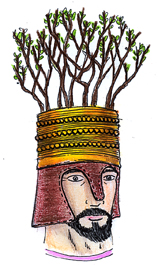 |
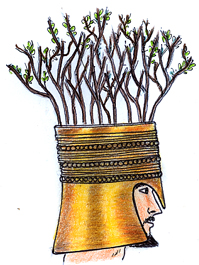 |
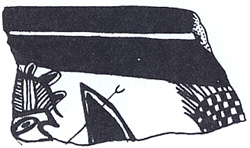 |
From the same island another rim fragment of a krater shows two helmets, only part of the warriors'head is preserved. At the left a soldier is wearing a tall semicircular helmet with a crest of tongues. The helmet body has a central vertical panel from which diagonal stripes splay upwards. The helmet front has a curved projection like a primitive nose guard. Even if not visible cheek guards could have been also present.
On the right only part of a helmet remains, a tall bag-shaped cap with straight sides and curved top, painted in checker-boards, surmounted by a crest of tall rays, possibly a version of a "feathered headdress". Also in this case the general shape of this last helmet shows close parallel with the above mentioned tall headgears from Portes, Photoula Praesos, Lakkithra and Kallithea | .
|
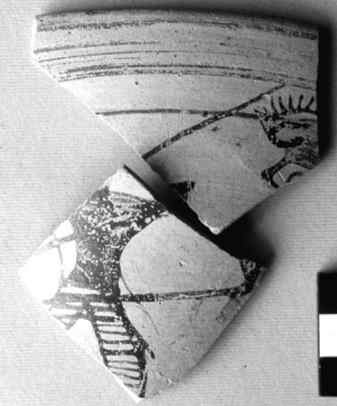 |
A tiara like helmet seems also represented on the head of the warrior on the right of these pottery fragments from Naxos dated LH IIC. The warrior on the right seems equipped with a bronze cuirass and some kind of banded protections in the lower body and legs. | .
|
| A beautiful example of late achaean bronze helmet has been found in the grave XXVIII from Tiryns dated around 1060 BC. This specimen is composed by four elements for the conical cap and two long cheek guards, all these parts have an average thickness of about 1mm. The two conical shell are 17 cm high and in the lower part 22.5 cm large, a decorative triangular motif follow all the shells profile and in the middle of each part a circular embossed decoration is also present. Two bronze bands about 30.5 cm long and 5 cm large are placed in the central area between the two conical shell. These elements have three holes in both the ends probably used to fix a wood crest holder. The two cheek guards are 16 cm long and in the larger part 9 cm wide, also in these part a central embossed decoration is present. |
| 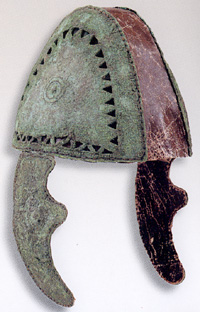 |
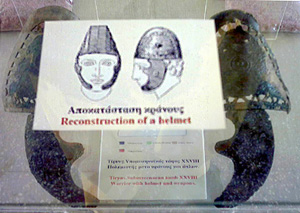 |
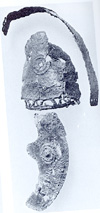 |
All the elements of this helmet have small holes all around the edges used for attachment of a lining to the inside of the bronze helmet parts. This internal perishable material padding is intended both as protective lining than as inner structure used to fix together the various parts.
The composition of this helmet with four parts and two cheek guards is in accordance with the indication on the Linear B tablets from Pylos dated around 1200 BC where the helmet ko-ru-to is indicated as composed by four elements o-pa-wo-ta and two cheek pieces pa-ra-wa-jo. |
|
| In this reconstructive drawing the Tiryns helmet is equipped with a crest made of separate tufts which was sometime used in the late achaean time as attested in some pictorial representation. The helmet has been represented worn over a fabric cap similar to the one represented in the fresco from Pylos. The embossed motif present on the shells and cheek guards is similar to the typical decorative elements used in late bronze age helmets and cuirasses attested in the central Europe areas. |
| 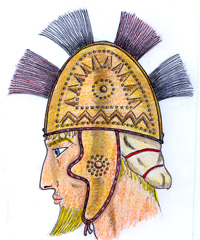 |
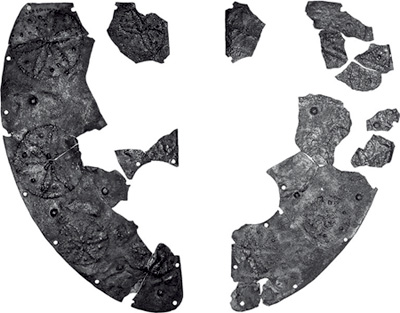 |
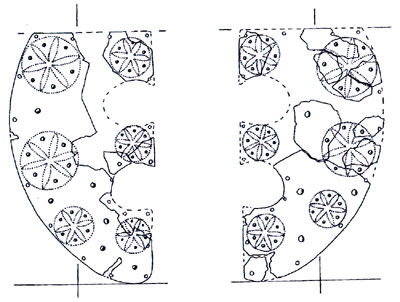 |
Some decorated bronze fragments from the grave 40 in Kalorisiki Cyprus dated about 11th Century BC, which have been wrongly reconstructed as upper elements of a trapezoidal shield, are acually two cheek guards of a conical helmet.
These guards are 17.2 cm long and 8 cm wide in the larger parts and are decorated with star motifs. |
|
Some bronze bands from the same grave 40 in Kalorisiki Cyprus, which have been wrongly reconstructed as edge reinforced elements of a trapezoidal shield, are acually the upper crest holder of a conical helmet.
These bands are 2.5 cm wide and had a presumed total lenght of about 120 cm (survived parts 95 cm) one element is bended with an angle of 70°.
These bands have holes for crest fixation and were attached to the upper shell of a conical helmet not survived which could be made both in leather or in two part of conical bronze shells thus similar to the Tiryns helmet or some Central European late Bronze age helmets. |
| 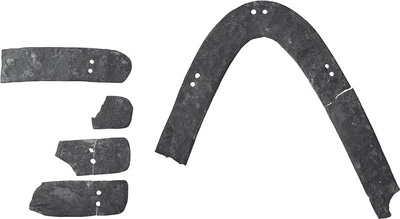 |
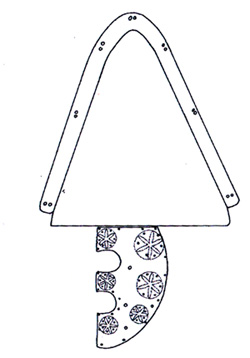 |
The helmet from the grave 40 in Kalorisiki Cyprus can be thus reconstructed as a conical helmet about 28 cm high with an upper crest holder and two large decorated cheek guards.
This helmet show closer similarity with the late Achaean helmet from Tiryns and some representations of Late Bronze Age Hittite helmets.
(For the relevant archaeological report see: Matthaeus, H. , Schumacher- Matthaeus, G., Ein Spaetbronzezeitlicher Helm Von Der Insel Zypern, Kulturelle Beziehungen Zwischen Dem Urnenfelderkreis, Mykenai Und Zypern, Jahrbuch des Roemisch-Germanischen Zentralmuseums 59, 2012) |
|
| Similar cheek guards were found in Phaistos (Crete). These elements together with a shield boss and perhaps a part of a belt were contained inside a large pithos in an cult dated around the 7th-8th century BC although the elements may have belonged to a "local hero" of the XII-XI century BC whose cult was still celebrated during the archaic period |
| 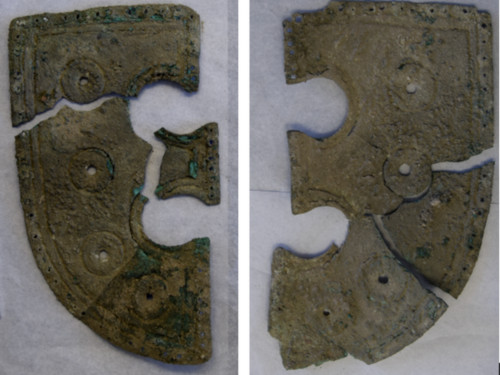 |
| A very strange crest with striped, triangular cup-socket (plume with dots down back, single plume in front) is on the top of a conical helmet represented in this small krater fragment from Mycenae dated LH IIIC . |
| 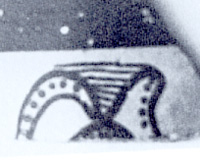 |
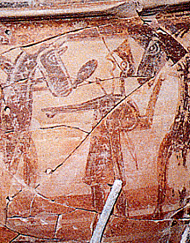 |
Simple conical helmets were largely used during the late achaean period. In this achaean krater from Pyla-kokkinokremos Cyprus dated LH IIIB two warriors and two charioteers are wearing conical helmets even if because of the painting stylization no other elements can be identify. This crater attested as in some cases (more likely in non-combat situation) the swords were also carried on the back. |
|
| Another simple conical helmet is represented in this sculpture of a horse-mounted warrior from Mycenae dated LH IIIB. The warrior is also equipped with a sword beared at chest level. This sculpture is another clearly evidence that during the late achaean time the horse mounted warriors were also present. |
| 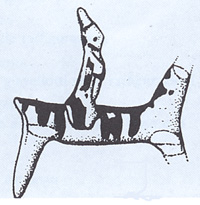 |
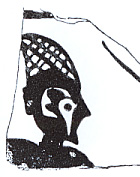 |
A conical helmet or cap in this case probably made of perishable material is depicted in this krater fragment from Mycenae dated LH IIIB . |
|
| What seems to be an high conical helmet with two horns is depicted in this bull-games scene depicted on a pottery fragment found in Mycenae date around LH IIIA2-LHIIIB (about 1300 BC). |
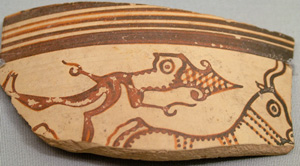 |
| Another high conical helmet with fringes is depicted on a pottery fragment also found in Mycenae date around LH IIIB-C (about 1300-1200 BC). |
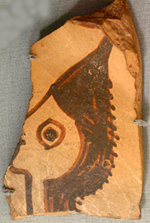 |
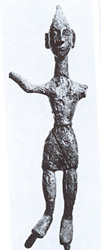 |
 |
Conical helmets with horns (no more present but attested by the relevant lateral fixation holes) are represented in these two bronze statuettes respectively from Thermos Etoly and Patso Crete dated LH IIIC and LM III. Because their rigid shape these helmets have to be more likely intended as made of bronze. |
|
| High conical helmets with an upper curl are worn by some warriors depicted in this Mycenaean krater fragment from Ugarit Syria dated around 1200 BC. Also in this case because the artist stylization no further details can be identify. |
| 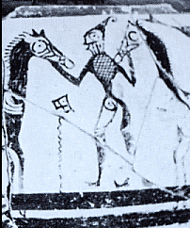 |
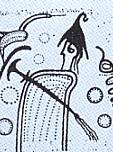 |
Another conical helmet with upper curl is represented in a naval scene on a Mycenaean krater from Enkomi Cyprus dated LH IIIB1 (about 1300 BC). In this case the helmet seems also equipped with nose protection and neck guard. |
|
| Different type of high conical helmet with a large upper knot have been represented in these two bronze statuetes respectively from Delos dated LH IIIA-B and Mycenae dated LH IIIC. These helmets are without cheek guards and because their general design and rigid shape are intented to be made of bronze. |
| 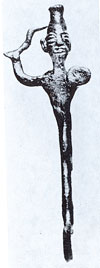 |
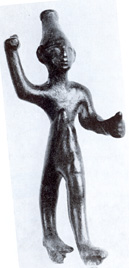 |
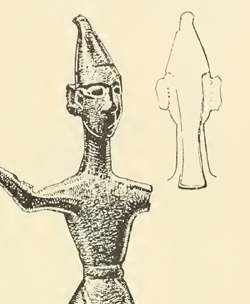 |
Similar type of high conical helmet with upper knot and long neck protection is represented in this bronze statuetes from Cave of Hermes Kranaios near Sybrita Crete also dated LH IIIC. |
|
| A conical helmet is worn by the warrior or deity represented in this bronze stauette covered with a gold lamina from Cyprus dated about 1200 BC |
| 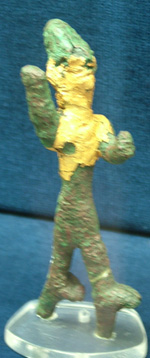 |
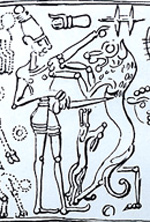 |
Another high conical helmet with a large upper knob is also represented on this seal dated around 1300 BC from the new palace of Thebes. |
|
| A similar type of high conical bronze helmet with upper large knob and with three horns is also well represented in this bronze statuette from Syria dated about 1200 BC. |
| 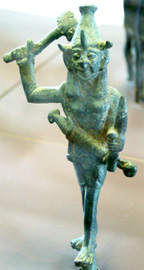 |
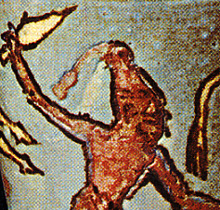 |
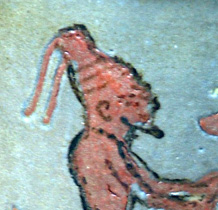 |
This type of high conical helmet with upper knot is also depicted in two hunting scene on a rhyton of faience form Cyprus dated thirteen century BC. In this case two crests are attached to the upper Knot. |
|
| On a fresco from Mycenae dated around 1250 BC similar high conical helmets are worn by three warriors. On the first helmet starting from the left an upper circolar crest seems to be present, in the second helmet two horns located in the upper part are visible. |
| 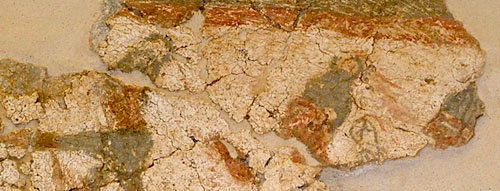 |
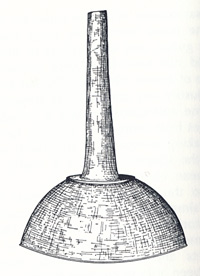 |
What it seems to be a bronze helmet cap or upper part of helmet with cilindrical upper tube for crest holding dated around 1200 BC has been found in Enkomi Cyprus. |
|
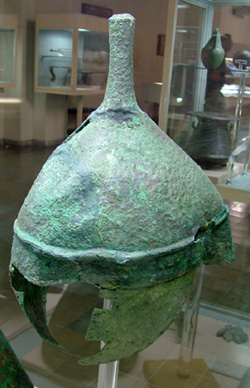 |
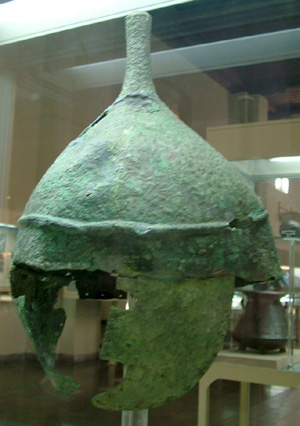 |
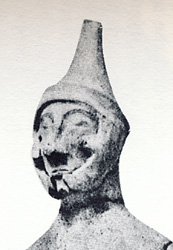 |
Other similar bronze helmets with cheek guards and upper long conical tube were used in Cyprus untill the late 7th Century BC. The bronze specimen is coming from the Royal grave IV in Tamassos. The terracotta sculpture dated from 900 BC to 750 BC or from 700 BC to 600 BC is from Ajia Irini and it represent a warrior with an helmet shaped like an inverted funnel with cheek pieces very similar to the ones of the helmet found in Tiryns. |
|
| Conical horned helmets are represented on some Minoan linear sign which, in a semi-pictorial form, already appears on inscribed clay bars of Mallia, going back to the earliest phase of MM III (about 1600 BC). These representations already show traces of the chin straps, and the rows of boars' tusks have left their traces in the case of image b. |
| 
Helmets ideograms from Mallia |
| The helmet is attested in the linear B also with a figurative ideogram from Knossos (KN 191) in shape of a conical element with cheek guards. This ideogram appeares in four tablets with the relevant associated name ko-ru (nom. sing.). |
|
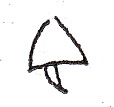
ideogram from Knossos |
On the tablets from Pylos the helmet is represented as a simple cone on the top of the entire armour (see the page dedicated to the armour). In these tablets the helmet is indicated as ko-ru-to (gen. sing.) sometimes also in its short form of ko- as specification of the relevant o-pa-wo-ta (things attached around) in number of four and the pa-ra-wa-jo (cheek guards) in number of two. More likely these metal elemets were jointed together on a non metallic substrate to compose a complete helmet similar in shape and design to the bronze specimen found in Tiryns. |
|
| The helmet is also named in the strumental plural form ko-ru-pi on a tablet from Pylos (Ta 642) related to decorative motif for the palace fornitures, and in the derivate adjetive e-pi-ko-ru-si-ja and e-pi-ko-ru-si-jo in the tablets from Knossos KN Sk 8100, 8149 and KN Sk 789 as attribute to the o-pa-wo-ta. |
| CENTRAL EUROPE HELMETS
|
| From the rest of Europe worthy to be mentioned are some bronze helmet of Urnfield culture found in Germany, Austria, Poland, Slovakia and Hungary because their vicinity with the Achaean mainland and because they fall to the same time period as the Greek Bronze Age civilization, either before or after the collapse of the palace system. Furthermore these helmets show similarity in features and decorations with some late achaean specimens. |
|
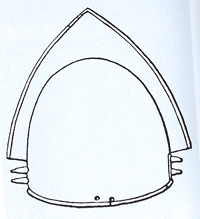 |
A bronze high conical helmet with metal crest dated around 1200-1100 BC is attested from Lesum Germany. This type helmets was very common during the late Bronze Age in the north and central areas of Europe being similar specimens found also in South Germany and France. |
|
| A simple conical bronze helmet with upper knot used to support a horse tail date around 1200-1100 BC is attested in Beitzsch Germany. This helmet is similar in general design to the specimen found in Crete (even if without cheek guards) and to some conical helmets shown in achaean pictorial representations. |
| 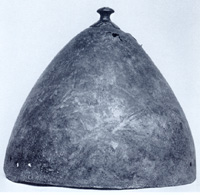 |
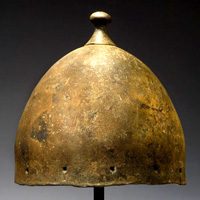 |
Basically the same type of helmet has been also found in Hungary dated around 1000 BC. The knob topping the crown has a hole for inserting a crest. It is ornamented with concentric grooves and a band with diagonal hatching.
|
|
| Another conical bronze helmet with a large upper knot used to support a horse tail date around 1000 BC has been also found in Central Europe area probably Austria. |
| 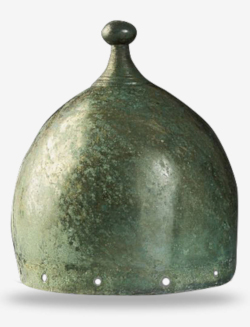 |
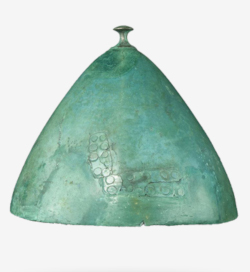 |
A beautiful conical bronze helmet dated 12th 11th Century BC has been also found in the area of Voecklabruck in Austria. This specimen show on it surface some small rivetted plates probably parts of a reinforcement applied as damage repairing
|
|
| A semiconical bronze helmet dated around 1100-1000 BC has been found in Finkenwalde near the border between Poland and Germany. This helmet has a top pipe for horse tail instalation and holes in the lower rim used to fix a perishable material lining. The embossed decoration of this specimen are similar to the ones attested in the late achaean helmet from Tiryns. |
| 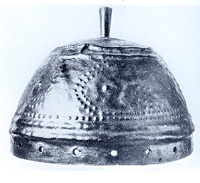 |
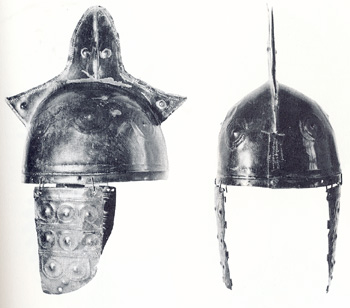 |
A very interestig embossed bronze helmet probably dated around 1200-1100 BC is from Pass Lueg Austria. This type of helmet was made of two pieces rivetted together, it has a tall cret holder and large cheek pieces joint on the helmet's lower edge by means of metal ring. Also in this case the decorative embossed motif are very similar to the ones attested in the helmet from Tiryns. Because its general design and vicinity with the Greece mainland this type of helmet was probably strictly related with some types of north achaean Late Bronze Age helmets. We can also suppouse that the bronze variant of the warrior vase helmets represented in the side A were more likely made in this way. |
|
| Bronze helmet probably from Hungary dated around 11th-10th century B.C.
This bronze helmet with a high, conical domed bowl,is surmounted by a low metal crest. It is made in two halves which overlap and are rivetted in the brow and neck area. The surface is decorated with bands of small raised bosses, which are bordered by rows of small raised dots. Each side also displays two large, four-spoked, wheel-shaped ornaments. Irregular holes in the lower rim served to attach a lining, while two very carefully punched holes in each side were used either for suspending cheek guards or fastening a chinstrap. Another hole pierces the peak of the crest.
The helmet is slightly deformed, with a few small additions to the bowl and the rim area, which also has a small defect of c. 5 x 3 cm on one side. Height 24.5 cm.
|
| 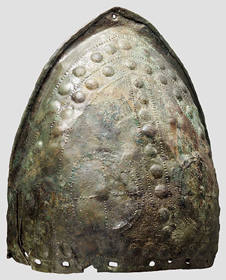 |
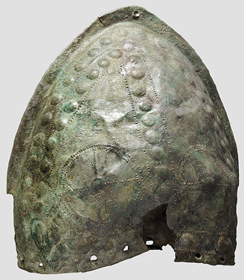 |
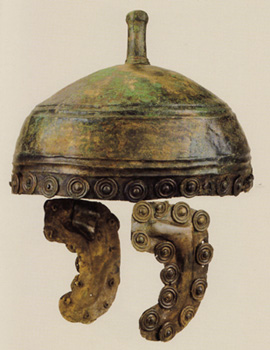 |
Very interesting bronze helmet with embossed lower ring and cheek guard of Urnfiled culture mostlikely from Hungary. |
|
| A similar bronze helmet probably of the same period has been also found in Ziarnad Hronom Slovakia. |
| 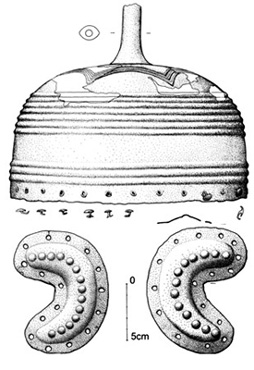 |
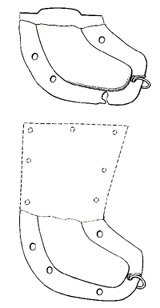 |
A partialy preserved bronze cheek piece was found in Woellersdorf Germany. This specimen has small holes to fix and internal linen and a metal ring used to hold the leather chin strap.
Also in this case the ceneral shap shows similarity with some types of cheek guards attested on specimens and representation in different Aegean areas. |
|
Two other well preserved bronze helmets similar to the one from Pass Lueg have been found in Trhoviste Slovakia (close to the Ukrainian border) dated around 1100-1000 BC.
Together the helmets also two cheek guards and two spiral arm protections have been found . |
| 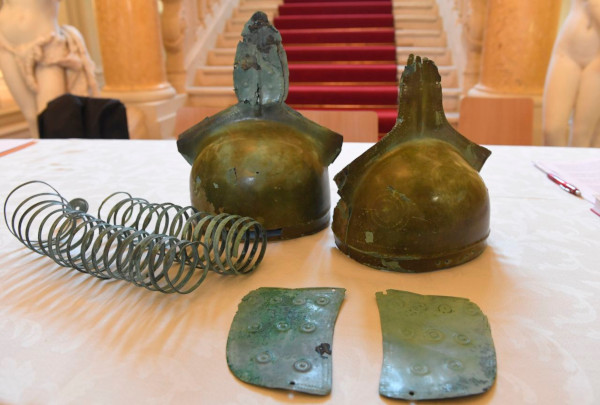 |
| CONCLUSION
|
| Several different type of late achaean helmets are well attested in findings, and art representations. During the final phases of Late Helladic time the achaean helmets made of boar tusks and the conical ones made of concentric bands were still use even if their utilization was less common respect to the early and middle periods. Different type of bronze helmets were also used as more likely attested in several art representations like fresco, pottery and statuettes and by the specimen found in Tiryns and Cyprus, these type of helmets (also mentioned by Homer) were sometimes decorated with emboseed motif and they show closer similarity with the bronze helmets found in central/north Europe locations. Horned helmets of various type increase in popularity in all the Aegean area just before the final period of the Late Helladic time. Well attested in the Greece mainland are also the "hedgehog" style helmet probably made of un-tanned animal skin sometimes reinforced with metal bosses. In the same period the as called "Feather Headgear" was largely used in some Aegean and central/south/east mediterranean location as well shown in several relief and pottery representations also coming from places under the achaean economical and military influence.
|
|